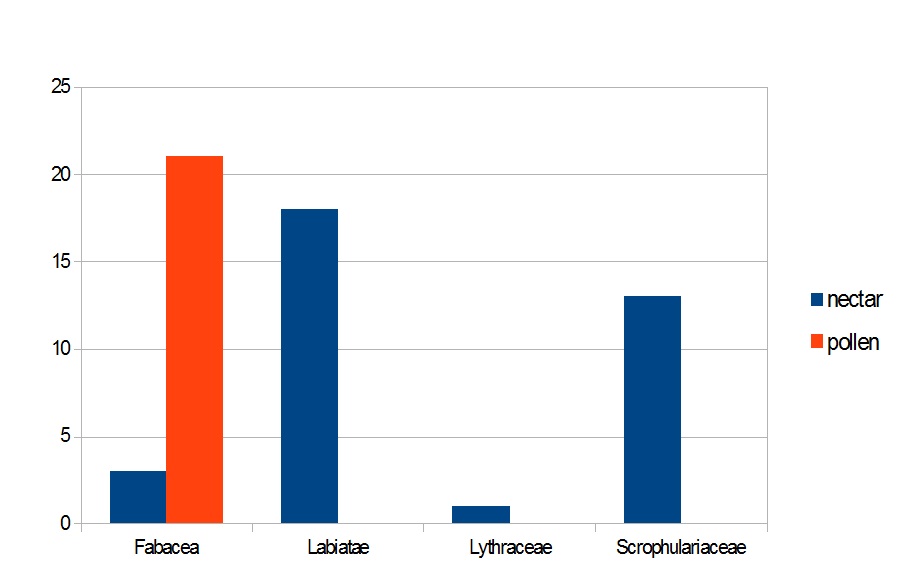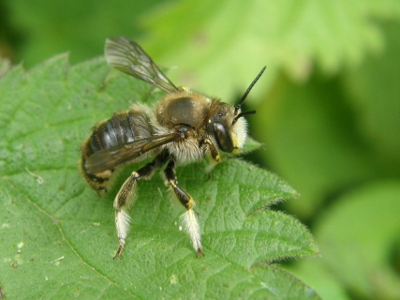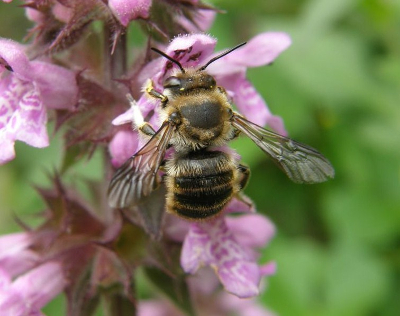

The Wool carder bee Anthidium manicatum is widely recorded in Cornwall from about 25 post 1990 sites. The bee can be associated with flower rich sheltered sites typically coastal cliffs or gardens. It is probably under recorded and it is difficult to establish the true status. Large stands of Marsh woundwort Stachys palustris are one of the best places to find the species. The bee collects hairs from plants which it uses to line its nest cells hence the name.
In 2013 I started a very simple study to try and establish what the key foraging requirements of the species. It is to be noted that the bee also has other nesting requirements.
Raw results, the observations taken during the flight seaon in both 2013 and 2014 were combined (Table 1.). They were classed into 3 catergories bees observed only nectaring, bees observed collecting nectar and possibly collecting pollen, and bees clearly collecting pollen.
| Observation | Nectar | Nectar & Unknown | Pollen | Total Result |
| Betony | 1 | 1 | ||
| Common birdsfoot trefoil | 3 | 3 | ||
| Greater Birdsfoot trefoil | 3 | 1 | 17 | 21 |
| Hedge woundwort | 1 | 1 | 2 | |
| Lemon balm | 1 | 1 | ||
| Marsh Woundwort | 15 | 2 | 17 | |
| Mint | 1 | 1 | ||
| Purple loosestrife | 1 | 1 | ||
| Purple toadflax | 14 | 4 | 18 | |
| Rest harrow | 1 | 1 | 2 | |
| Total Result | 36 | 10 | 21 | 67 |
The bees collected nectar from 9 sp. But were only definitely observed collecting pollen from Fabaceae in particular from Greater birdsfoot trefoil Lotus pendunculatus (Looe) and Common birds foot trefoil (Looe) but also Restharrow Ononis reclinata (Pentewan cliff).
9 species of flowering plants (n=46) had nectar observations. But a very limited number were favoured. Marsh Woundwort and Purple toadflax had collectively 35 observations.
The number of unknown observations in my study are a potential source of error. These are from difficulty establishing weather the bee is actually collecting pollen. The bee could be seen very definitely collecting pollen on 21 occasions, On these occasions clearly rubbing its back legs on the abdomen and rummaging in the anthers. But sometimes the bee was seen cleaning itself occasionally while nectaring which could have been borderline collection of small amounts of pollen, this was put down as n & un. (n=10)

Graph separating observations on the basis of plant families
Nectaring and unknown excluded from this graph. This study is very small but does tentatively suggest the bee is more specialised on Fabacea than the literature suggests.
On two sites I have planted small areas of Marsh Woundwort and Greater Birdsfoot trefoil close to each other and found the bee to arrive. On both of the sites this combination seems to attract other bees such as Anthrophora fucata. There is lots of scope in gardens to mix and match Labiate and Fabacea pairs and perhaps give beans on toast for bees.
Nest site found in 2015
"As a beekeeper, I regularly get calls from people with swarms in odd places, that they want removed.
On 9th July 2015, I had a call from a lady who was worried about a "swarm" of bees going in and out of her roof. The builders had erected scaffolding to replace the ancient leaky roof, and she was worried about the bees becoming homeless, and the builders being stung.
When I went to investigate on the following day, I found that they were not Honey bees, but a bee that I'd not seen before, the Wool-carder Bee, Anthidium manicatum, immediately told Paddy, as I knew that he'd be interested." (Bernard Hocking)
I met up with Bernard and was suprised to see good numbers going in and out from under the roof slates of the Cottage. Many of the slates had been recently removed and the nests were opened up to view. The amount of wool was incredible considering the amount of effort required to roll up balls of plant hairs and bring back to the nest, alongside this were larval cases in the hundreds. This must have indicated the site has been used over many many generations. see below


Larval cells surrounded by plant wool underneath a large slate at nest site

400x299.jpg)
Wool carder using plant hairs to build nests